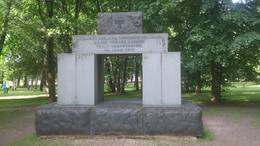Tartu švenčia 1919 m. pergalę Tähtverėje
Estijos nepriklausomybės karo metu 1919 m. sausio mėn. vykusio Tähtverės mūšio, kurio metu Estijos kariuomenė išvadavo Tartu nuo Raudonosios armijos, aprašymas.
1919 m. sausio mėn. vykusio Tähtvere mūšio, kuriame Estijos pajėgos išlaisvino Tartu iš Raudonosios armijos nagų, aprašymas.
Priešas paskutinį kartą bandė išlaikyti Tartu Tähtverės parke, pasiųsdamas į kovą Latvijos šaulių pastiprinimą. Šauliai, būdami patyrę Pirmojo pasaulinio karo veteranai, mokėjo išnaudoti reljefą savo naudai. Kulkos buvo šaudomos iš kiekvieno griovio, kiekvieno krūmo, kiekvieno kauburėlio, kiekvieno riedulio. Estų puolimas vyko lėtai. Iš šarvuočių, kurie atsiliko dėl geležinkelio remonto, buvo pasiųsti automatiniai šautuvai ir kulkosvaidžiai, kad paremtų fronto karius, tačiau tai buvo menkai naudinga. Mūšis siautėjo daugiau nei valandą, tačiau latviai nesitraukė. Juos rėmė 4,5 colio haubica iš geležinkelio stoties. Daugelis Estijos karių buvo sužeisti, tarp jų ir leitenantas Nepsas. Norėdami kuo geriau išnaudoti situaciją, eiliniai Selteris, Saaras, Ringenbergas, Sapuras ir kiti puolė į kairę, apsupdami Raudonosios armijos šaulius iš dešinės ir atidengdami ugnį į juos bei Tähtverės dvarą. Ši taktika sukėlė sumaištį tarp Latvijos raudonųjų, ir estai įgijo pranašumą. Tuo pačiu metu ką tik atvykę šarvuočiai pradėjo šaudyti į dvarą skeveldromis. Traukiniams artėjant, jų kulkosvaidžiai atidengė ugnį. Tai buvo lemiamas veiksnys. Padėtis pasikeitė. Raudonieji greitai atsitraukė iš mūšio vietos.
Postimees. 1944 m. sausio 14 d. https://dea.digar.ee/article/postimeesew/1944/01/14/13
Susijusios vietos
Tähtverės mūšio paminklas
Šis Aleksandro Ellerio suprojektuotas paminklas, skirtas Estijos pergalei prieš Raudonosios armijos latvių šaulius Tähtverės mūšyje 1919 m. sausio 14 d. atminti, buvo atidengtas 1932 m. liepos 3 d. Jis buvo nugriautas 1940 m., bet atstatytas 1942 m. Po karo sovietų režimas paminklą visiškai sunaikino ir galiausiai, 1957 m., pakeitė darbininkų ir profesinių sąjungų judėjimo veikėjo Hanso Heidemanno biustu. Paminklo restauravimą pasiūlė Ennas Tarto, o jis iš naujo atidengtas pradinėje vietoje 2006 m. liepos 2 d.





